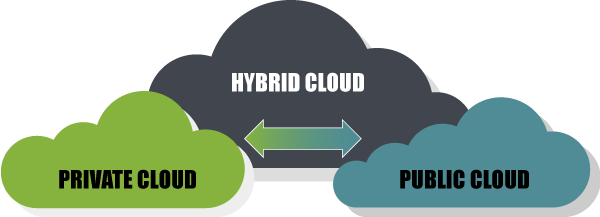Cloud infrastructure benefits
Cloud infrastructure in three cloud architectures
When it comes to cloud infrastructure, there are three architecture models through which it is delivered, with each offering a varying amount of security, control and management.
- Private: In the private architecture model, the cloud infrastructure is dedicated to a single client as resources are not shared internally. It is suitable for companies that desire a high level of security.
- Public: Public cloud architecture consists of third-party cloud service providers who offer cloud services to multiple customers. It uses a multi-tenant environment approach to lower the overall cost of computing resources whilst maintaining security for each client’s environment.
- Hybrid: As the name suggests, this architecture model is a combination of private and public cloud offerings in that it offers the efficiency of the public cloud environment and the security associated with a private cloud.
Cloud infrastructure components
Cloud infrastructure refers to all the hardware and software components needed to deliver cloud services to people and businesses. It is similar to any typical on-premise infrastructure, especially in terms of the functions it performs, but it is different in that it comes with a range of benefits that includes the lower cost of ownership, greater flexibility and scalability.
Cloud infrastructure consists of but is not limited to the following key components:
- Servers
- Software
- Network devices
- Other storage resources
These critical components are what allow for the development of applications that are then accessed via the cloud.
Benefits of cloud infrastructure
Although cloud infrastructure has only been around for a few years, the arguments in its favour have continued to increase. If you’re considering a switch to the cloud but you’re unsure of the benefits, here are some of the key advantages of using cloud infrastructure.
- Costs
Perhaps, the biggest advantage of cloud infrastructure for business is that it eliminates the operating expense associated with setting up, managing and upgrading your IT systems. Companies that adopt on-site IT infrastructure are usually burdened with costs ranging from hardware to software, energy, space, IT experts and more. With cloud infrastructure, you don’t have to worry about these bills anymore since your cloud provider invests in the underlying resources & maintenance while you pay only for the services you need per time.
- Scalability
Another reason why it makes sense to opt for cloud infrastructure is that it helps to tackle a problem like no other technology – the problem of scalability. Many businesses experience a challenge when they need to expand their operations as that may mean additional expenses for hardware purchases, more IT experts and so on. But with cloud infrastructure, you can scale up or down in an instant without having to forecast how many servers you may need.
- Security
One of the early misconceptions about cloud infrastructure is that they are insecure, but this has been disproved over the years. If anyone should worry about the insecurity of their data, it should be businesses that store their data onsite as they are constantly at risk of losing critical information due to data breaches, disasters, the predictable lifespan of hard drives etc. But with cloud infrastructure, there’s no cause to worry as providers keep a virtual backup of all critical data. They also put in place measures to forestall unauthorized access to your data such as stronger firewalls, two-factor authentication, advanced encryption etc.
- Mobility and collaboration efficiency
Cloud infrastructure allows for mobile access via smartphones and devices, provided there is internet connectivity. This in turn allows for staff with busy schedules to communicate and keep in touch with the rest of the team on site. You can also use cloud infrastructure to give contractors and third parties secure access to relevant files, thus enhancing collaboration efficiency.
- Increased productivity
When you switch to the cloud, you get to drastically reduce the risk of downtime, which means business operations never have to grind to a halt. Should you experience a natural disaster or other crisis, you can easily access your data in the cloud again to resume business as usual, effectively minimising downtime and loss of productivity. Furthermore, migrating your data to the cloud frees up your IT staff from tasks related to the maintenance of your IT infrastructure, so they can focus on other critical aspects of the business to improve the bottom line.
Conclusion
Many businesses are now moving their data to the cloud infrastructure because of the numerous benefits it offers for smooth business operations. If you’re looking to make the switch too, click on this link to get started.

